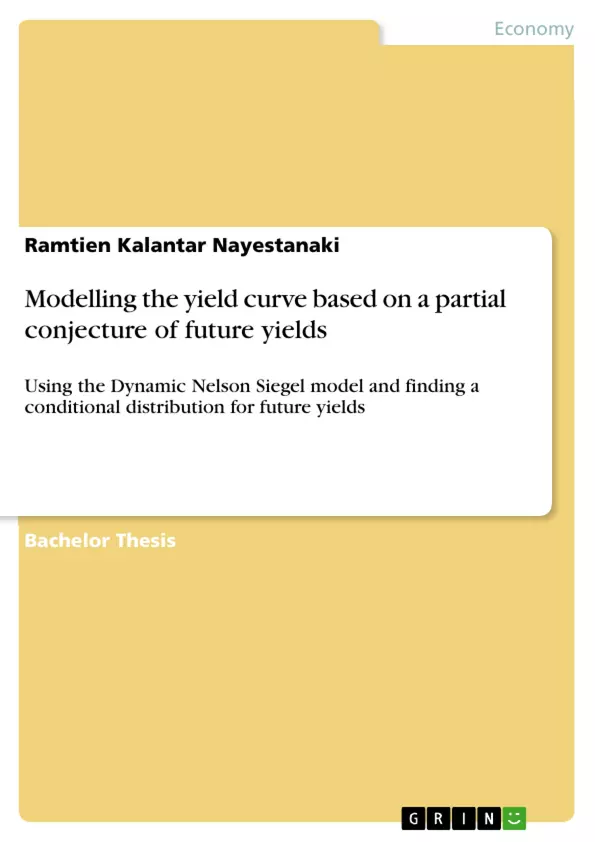
Modelling the yield curve based on a partial conjecture of future yields
Bachelorarbeit, 2016
30 Seiten, Note: 8
Leseprobe
Frequently asked questions about "Modelling the yield curve based on a partial conjecture of future yields"
What is the Dynamic Nelson-Siegel model?
The Dynamic Nelson-Siegel (DNS) model is a statistical model used for modeling and forecasting the term structure of interest rates, which is the relationship between bond yields and their maturities. It extends the static Nelson-Siegel model to a dynamic framework where the factors (level, slope, curvature) are assumed to be time-variant.
What are the key themes explored in this study?
This study explores term structure modeling using the Dynamic Nelson-Siegel model, factor dynamics estimation using maximum likelihood and Kalman filtering, forecasting future yield curves, and developing a stochastic model for predicting yield curves based on a partial conjecture of future yields.
What is the primary dataset used in the analysis?
The primary dataset consists of zero-coupon German Bund yields obtained from Bloomberg, spanning from January 2, 1998, to March 9, 2016.
What is the significance of the level, slope, and curvature factors in the DNS model?
In the DNS model, the level factor represents the overall level of interest rates, the slope factor represents the difference between short-term and long-term rates, and the curvature factor captures the bend or curve in the yield curve.
What statistical methods are employed in this study?
The study utilizes Ordinary Least Squares (OLS) regression, Maximum Likelihood Estimation (MLE), Kalman Filtering, and Vector Autoregressive (VAR) models to analyze and forecast yield curves.
What is the Kalman Filter and how is it used in this study?
The Kalman Filter is a recursive algorithm used to estimate the state variables of a dynamic system from a series of incomplete and noisy measurements. In this study, it's used to estimate the factors of the Dynamic Nelson-Siegel model.
What is iDNS and cDNS, and how are they different?
iDNS refers to the independent Dynamic Nelson-Siegel model, which assumes the factors (level, slope, and curvature) are independent of each other. cDNS refers to the correlated Dynamic Nelson-Siegel model, which relaxes this assumption and allows the factors to be correlated.
What evaluation metrics are used in this study?
The Root Mean Squared Error (RMSE) is used as the primary metric for evaluating the accuracy of yield curve forecasts.
What does this paper find regarding iDNS and cDNS performance?
The cDNS model performs better in out-of-sample forecasting, possibly because it models the correlation environment of the factors, but the iDNS model does better in in-sample forecasting.
What are the main findings regarding modelling predicted yield curves with future yields?
A stochastic model for the predicted yield curve can be created when a future yield with a certain maturity is known.
Details
- Titel
- Modelling the yield curve based on a partial conjecture of future yields
- Untertitel
- Using the Dynamic Nelson Siegel model and finding a conditional distribution for future yields
- Hochschule
- Rijksuniversiteit Groningen
- Note
- 8
- Autor
- Ramtien Kalantar Nayestanaki (Autor:in)
- Erscheinungsjahr
- 2016
- Seiten
- 30
- Katalognummer
- V352069
- ISBN (eBook)
- 9783668386990
- ISBN (Buch)
- 9783668387003
- Dateigröße
- 2359 KB
- Sprache
- Englisch
- Schlagworte
- yield curve modelling Nelson Siegel model factor dynamics Kalman filter forecasting
- Produktsicherheit
- GRIN Publishing GmbH
- Preis (Ebook)
- US$ 0,99
- Preis (Book)
- US$ 19,99
- Arbeit zitieren
- Ramtien Kalantar Nayestanaki (Autor:in), 2016, Modelling the yield curve based on a partial conjecture of future yields, München, Page::Imprint:: GRINVerlagOHG, https://www.diplomarbeiten24.de/document/352069
- Autor werden
- Ihre Optionen
- Vertriebskanäle
- Premium Services
- Autorenprofil
- Textarten und Formate
- Services für Verlage, Hochschulen, Unternehmen

- © GRIN Publishing GmbH.
- Alle Inhalte urheberrechtlich geschützt. Kopieren und verbreiten untersagt.
- info@grin.com
- AGB
- Open Publishing
Der GRIN Verlag hat sich seit 1998 auf die Veröffentlichung akademischer eBooks und Bücher spezialisiert. Der GRIN Verlag steht damit als erstes Unternehmen für User Generated Quality Content. Die Verlagsseiten GRIN.com, Hausarbeiten.de und Diplomarbeiten24 bieten für Hochschullehrer, Absolventen und Studenten die ideale Plattform, wissenschaftliche Texte wie Hausarbeiten, Referate, Bachelorarbeiten, Masterarbeiten, Diplomarbeiten, Dissertationen und wissenschaftliche Aufsätze einem breiten Publikum zu präsentieren.
Kostenfreie Veröffentlichung: Hausarbeit, Bachelorarbeit, Diplomarbeit, Dissertation, Masterarbeit, Interpretation oder Referat jetzt veröffentlichen!
- GRIN Verlag GmbH
-
- Nymphenburger Str. 86
- 80636
- Munich, Deutschland
- +49 89-550559-0
- +49 89-550559-10
- info@grin.com
-









